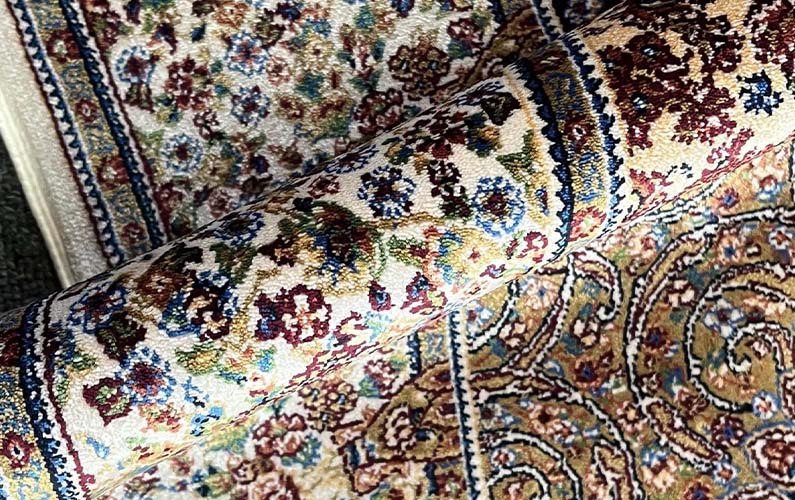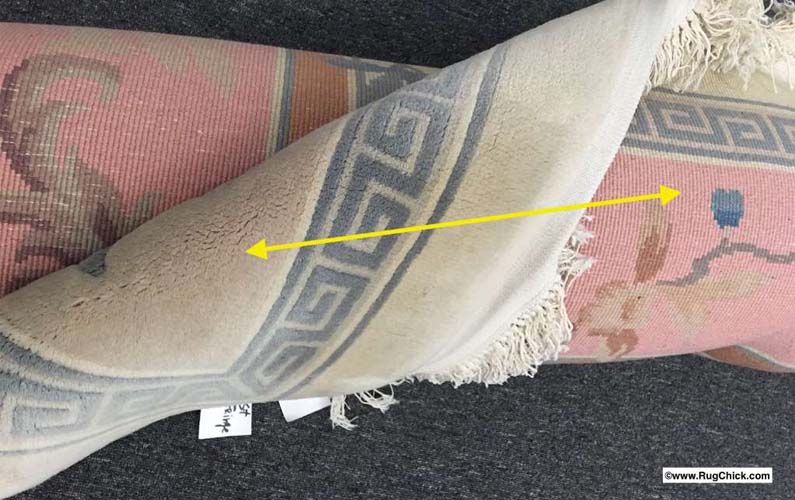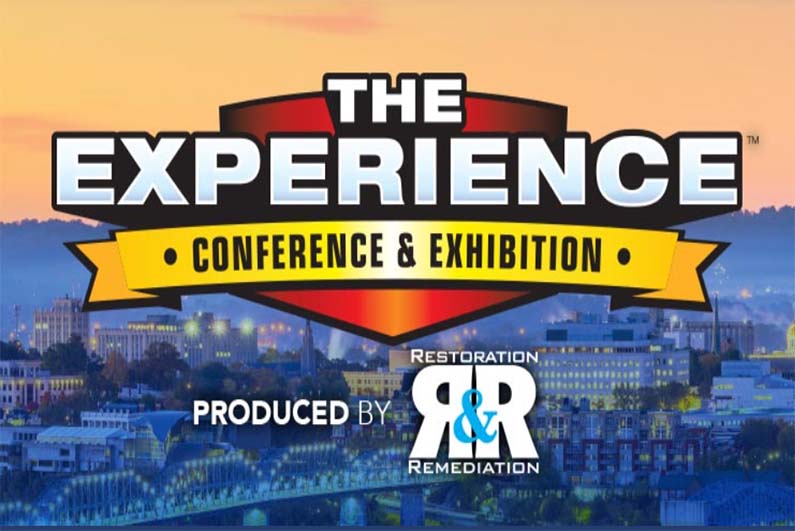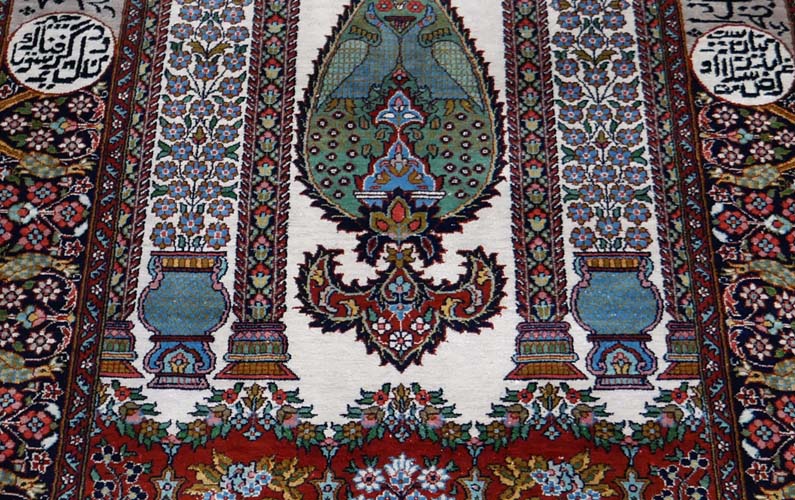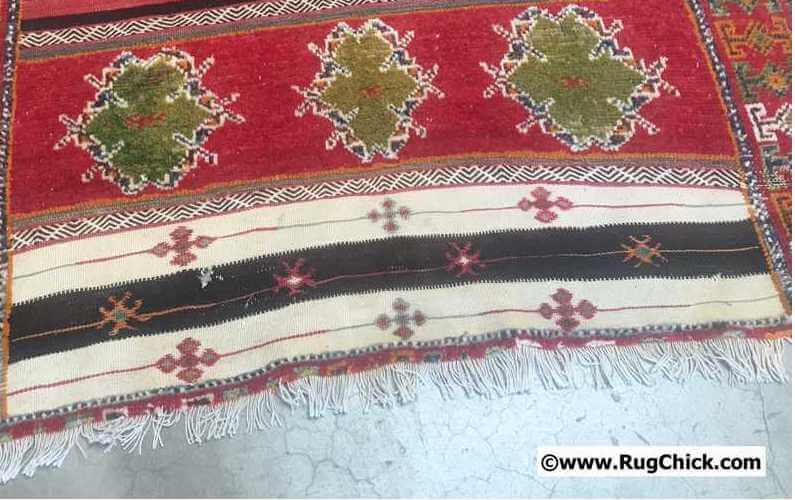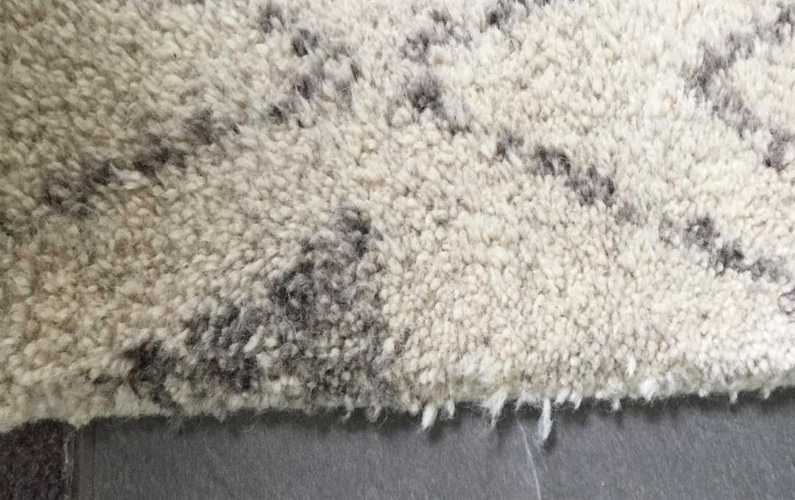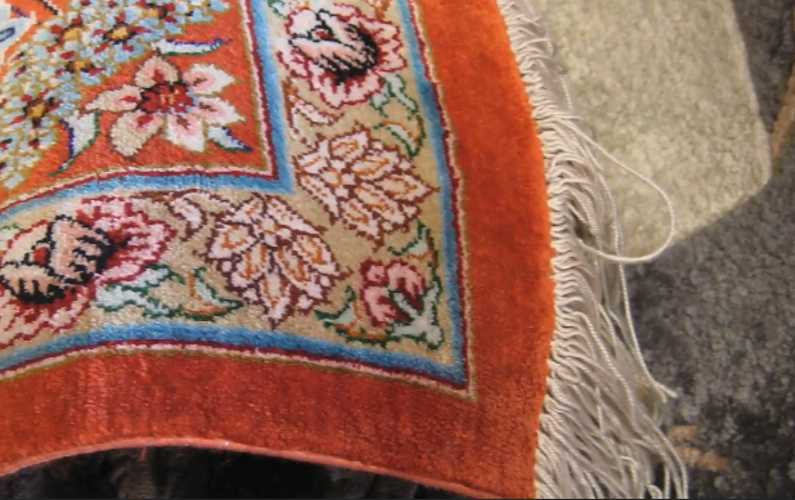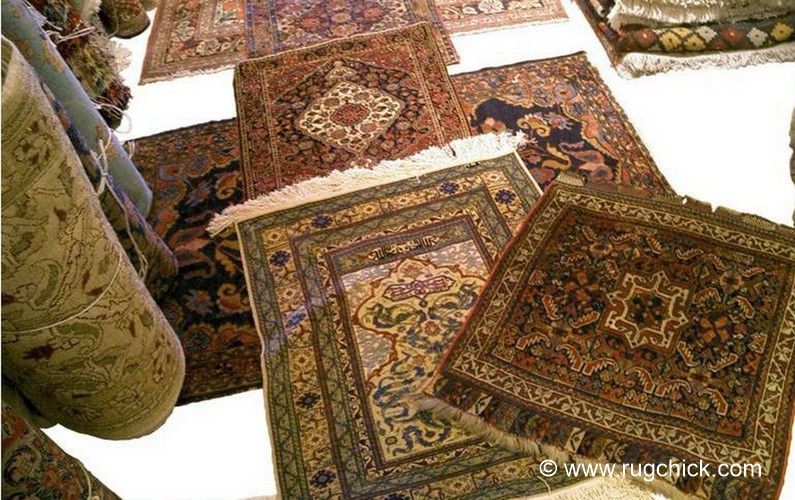Rug Shop Set-up. (The mother of all equipment posts)
The most common question I get from professional carpet cleaners (besides “oh God, can you help me save this rug!”) is this => “What rug cleaning equipment should I buy?”
And my answer is always the same.
It depends.
Are you doing rug cleaning as an occasional add-on service, or as your primary service? Are you expecting to wash 5 rugs a week, or 500? Do you have a trained team to support larger volume?
What amount of space do you have? What kind of capital do you have to sink into pouring a wash floor and getting larger equipment? What equipment do you already own free and clear? Are you picking up and delivering?
How much do you really enjoy rugs? Is it a passing fad (like the other equipment you just sold off at the last carpet cleaners swap meet…) – or do you want to truly be a Textile Pro?
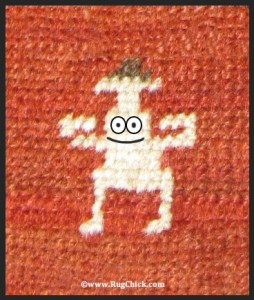
Are you a rug enthusiast? =)
I have helped more professional carpet cleaners start up into the rug cleaning craft successfully than perhaps all of the other trainers lumped together. Here’s why.
I had a distributor friend of mine who has hosted four IICRC courses (taught by others) over the past 2 years poll the students to see how many were TODAY actively cleaning rugs full-time as a result of the class. The answer… THREE. Out of almost 100 who attended and got “certified.”
That is sad. But it’s also a sign of uncertainty. If they did not leave the class confident about cleaning rugs (or even knowing how to GET the jobs), it makes sense they would stick to their prior comfort zone. Rugs can be scary if you don’t understand them.
That said, I can point to Piranha Members and Rug Secrets alumni of mine all over the US, Canada, and overseas, who are actively cleaning rugs and growing their rug cleaning companies.
So why are my “students” not quitting? It’s the same reason you are reading this blog post. Because I make “sense.” I teach in a very clear style. And when you understand something, you TAKE ACTION on it.
I also have a very clear understanding on how to be smart about growing a rug cleaning company. I’ve seen enough people do it wrong and crash and burn, and I don’t want to see that with any of the cleaners and restorers I work with.
So instead of pushing them into some huge equipment lease package (that I may or may not get a kick-back from…LOL) – I am very conservative with them. I show them low-tech options to build their skills in (and make sure they LOVE rugs…), and then graduate up to cooler, pricier options when they are ready.
So…with this post I am going to throw out every tool option to come to mind on how to properly set up YOUR rug cleaning workshop. Bookmark this post, because you are going to come back to it. And I’ll organize it from “low tech/small money” to “high tech/BIG money” so that you can truly choose what is best for you in your current financial and space position.**
(**My disclaimer** – I am listing options for your information, this is NOT an endorsement by me of any item in particular. I will tell you what we actually use, but that does NOT mean this is the *best* choice – it’s just what we use and like. Anything not shared does NOT mean you shouldn’t buy it… it means perhaps I don’t know about it. And of course everything in this blog, and all of my blogs, is my opinion only. I know a lot, but I do NOT know it all. It’s because there is a lot of misinformation out there about rugs that I’m sharing this. All suggestions require trained cleaners – so please don’t be a *rug idiot* and see a rug wet and think any rug can just simply be dunked with no consequences. Education is required and should be invested in before the equipment.)
Most Important Factor => The Rug Cleaner not the Rug Cleaning Equipment
We began our washing process in the back sloped cement driveway of our antique rug gallery in sunny La Jolla, California. We kids were “rug brats” who climbed the stacks of rugs like the Himalayas, and helped scrub rugs by hand outside with our parents – just like a car wash (wax on – wax off!!!). It was fun, it was low tech, and the results were great.
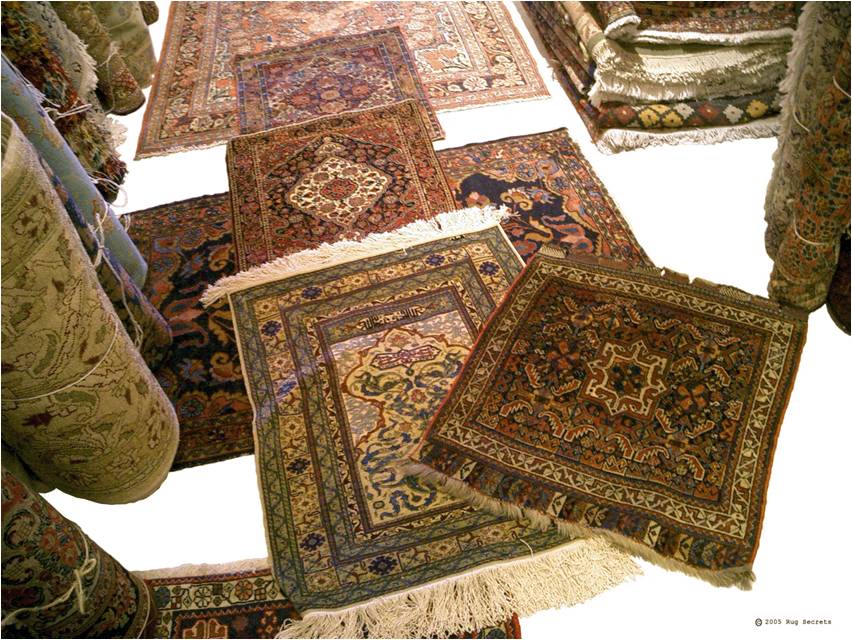
A garden of rugs…
There are very large automated rug cleaning plants in Los Angeles, couple hours north of us. A thousand rugs a week going through them. Very little prep work, just feed it on the treadmill, every rug exactly the same. Like an automated car wash…you can end up still with dirt on the side doors or caked on the windshield.
Now – I can guarantee you that I can out clean one rug versus the big operations in LA, because I would be focused on creating the best result possible. It would take me several hours…but I would out clean them in quality, even with low-tech tools (a vacuum, bucket of suds, hand brushes, squeegee, cool water, a wet vac, and white vinegar to stabilize the dyes and rinse). My “boutique” rug operation could have stellar results… but only be able to do a few rugs a day. It would be more labor-intensive.
I would be the “car detailer” versus their “”automatic car wash” – and just like real detailing gets me $125 versus the $9 drive through wash – I would be able to attract investment rugs to care for by my expert hand.
The best LARGE rug cleaning operations are a combination of these two styles, with the care/attention of a boutique workshop on the wash floor BEFORE and AFTER it is fed through the automatic rinsing/wringing process. I can name a half dozen operations in my head across the US that have that level of quality. Unfortunately, for as many great large operations as there are, there are not-so-great ones too.
My point though is this – larger equipment options do not automatically equal “best” cleaning. You can have best with low-tech. It falls more on the care and attention to detail of the RUG CLEANER, and not the rug cleaning equipment.
What the equipment does is this – it allows you to perform wash process steps more efficiently. And being more efficient allows you do get more done in the same time.
So my advice to those getting into the business is start low-tech, and move up as you grow. I’ve seen several friends sink a fortune into large equipment and space, thinking “if I build it, they will come,” and then go out of business.
The rug cleaning business is a growing opportunity – but it is not “easy” money. It’s hard work. (Business owners are not afraid of hard work…as long as it’s something they really enjoy.) So you better make sure you are crazy about rugs before you dive into the deep end.
Here are the main steps of the rug wash process – and some different equipment options/ideas for you.
DUSTING EQUIPMENT
SMALL bucks => Vacuum Cleaner
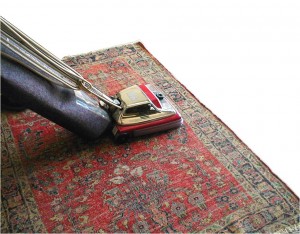
Vacuum back of rug to “shake” loose soil.
If you already own a good beater bar vacuum, then this option is “free” for you. By dusting the back side of the rug, you shake/vibrate loose the embedded soil in the rug. As you saw in the last blog post on “Why rugs are not cleaned in the home” – this is a VERY important first step to proper rug cleaning.
We use commercial Sanitaire upright vacuum cleaners, with the brushes in the bar replaced with metal slide in plates, because the “bristles” are not needed. They are super sturdy, and work great, so we’ve never needed to “move up” to bigger, louder equipment here. However, our clients value their rugs and keeping their homes clean so they wash them regularly, and don’t let them get caked up in abrasive soil and contaminants.
Placing rugs over tile grates or mats can help elevate rugs so that more soil can shake loose and away from the rug. I did a Google search for “interlocking plastic floor tiles” and came up with a wide variety of colors and strengths. This can be used for a dusting platform, as well as to place in a wash pit (if you do not have a wash floor poured yet…) to allow water flow under the rug, and to keep you from slipping. =)
UPDATE
A few of you have contacted me asking about the metal slide in replacements for the brushes on the Sanitaire vacuums, and that you have had problems finding these parts. I’ve been told to contact Jon-Don and ask for Fernando, and he knows EXACTLY what you are looking for. You also can get a narrower design brush which works very well for dusting/vibrating rugs from the backside – we use the Sanitaire Alumimum VGI-12″ Brush Roller for this. Let me know if you have any other questions on this. Or Google that word “Sanitaire Aluminum VGI-12 brush” to see what it is. Thanks!
End Update
BIG bucks => mini-DUSTERS, compressed air dusting, large dusting machines
There are two portable “mini” dusters out right now in the US. I’ve only used one, the Rug Badger:
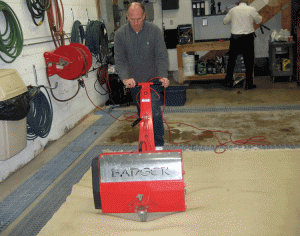
Rug Badger removed soil by beating the back of the rug.
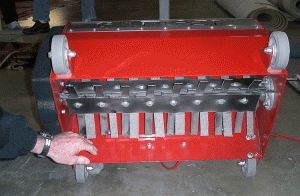
Straps “smack” the back of the rug.
I know a number of cleaners who own a Rug Badger and are very happy with it.
For dusting options, you have the small portable dusters, large tumble dusters, compressed air dusters, and large automated dusting machines. Options at every budget.
I also came across another company building mini-dusters in Greece. (Many long established rug cleaning operations purchase their large and small rug cleaning machinery from Turkey and Greece – which makes sense because many rugs are woven there, so they require these machines to wash the rugs before they are sold.)
A bid I received for this particular unit, which has a roller on the front to hold the rug down securely (they are sending me photos of the rest of the construction) – was $2,000 for one unit (lower pricing for more)
With international freight costs, this might not be cost effective, but I wanted you to be aware of all the options I have seen.
Another option is the compressed air dusting system which is part of the overall Auserehlian Oriental Rug Washing system, which incorporates a large inflatable wash pit and several proprietary tools to create a “jacuzzi wash.” Phil Auserehl and Ron Toney are the “pioneers” of the rug bath system we see in many cleaning operations today.
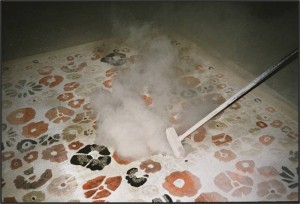
Air dusting with the Auserehlian method.
Air dusting is a very thorough method. Obviously good containment is required, and a good compressor to power it. It’s my understanding that you buy the complete system, and not just the “dusting” tool ala carte.
Large automated dusters, where you feed in a rug to be beaten as it is rolled through a system of straps, also are available. Here is one by Centrum-Force that shows the straps along top.
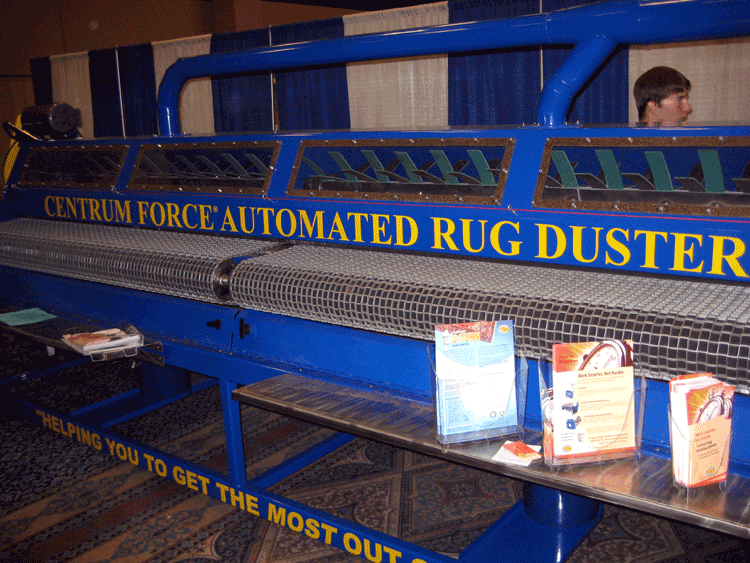
Automated dusting machine on display at trade show.
Here are several companies that provide complete rug cleaning equipment options: US-based companies (Rug Sucker, Centrum Force, Orbitec Solutions), European based companies (Protima – POLAND, Hanta Systems – GREECE, Cleanvac – TURKEY). Remember if buying overseas to connect with a reference of a company who owns the equipment already to determine the cost of freight and motor and/or electrical work that might be needed so you have a complete picture of the process and cost in your country.
There also are second-hand large equipment from long-time companies closing their doors, so you will see some Mor equipment available. This was a long time builder of large rug/carpet machinery in Illinois. Though some of his pieces also look very familiar when compared to these Greek and Turkish suppliers, so I do not know if Mor manufactured his pieces from ground zero, or if he ordered parts from Europe and assembled them in the US.
Today it seems that “parts” are mostly made overseas. I know my “American” car is made of European parts. My friend’s German BMW was built in the US, with German parts, but is considered a German car. So I would not be surprised if there are a few core suppliers of main components for many rug washing companies, because with this large equipment, they all look very similar. But, that is simply an observation I could be 100% wrong on.
Those are your choices – low tech to high tech.
WASH/RINSE EQUIPMENT
Small bucks => D-I-Y Wash Pit*
(*Before you get ANY rug wet, you better know what you are doing. Be sure you are fiber testing, dye testing, checking the structural integrity of the textile, and using the proper cleaning chemistry and techniques to safely and thoroughly clean the rug. All photos shared are from experienced plants and experienced cleaners.)
First off, if you have an existing sloped (and clean) surface, with an ability to capture the water so it does not go into the storm drain, you may not need a “pit” at all. Depends on what you have.
But a pit can be as low-tech or high-tech as you want. A simple tarp with some PVC pipes with elbow joints to make a pit is the lowest-tech way.
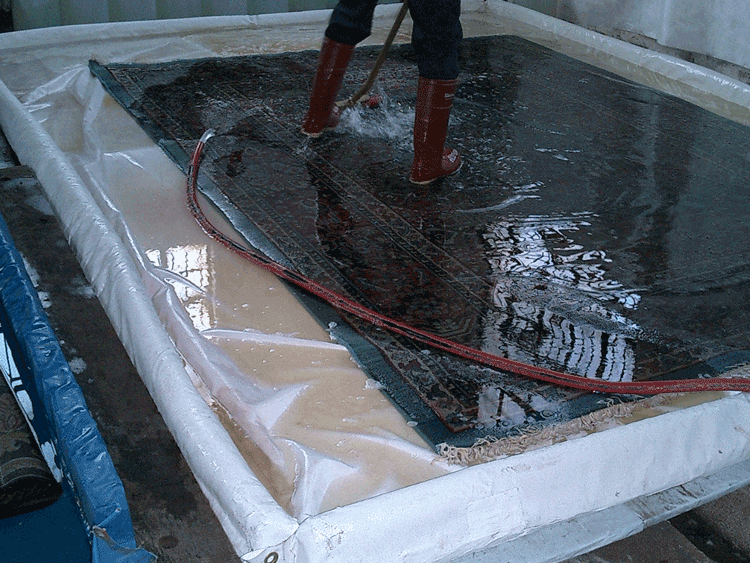
Low-tech D-I-Y wash pit.
Many rug cleaners start with a wash pit made of pond liner, but the preferred choice would be a Versafloor by Rug Sucker Systems and the Marinator for decontaminating pet urine from rugs.
Medium bucks => The rug instructors pits-ready-for-you packages.
In past rug workshops I’ve taught, we used a wash pit that had an inflatable perimeter:
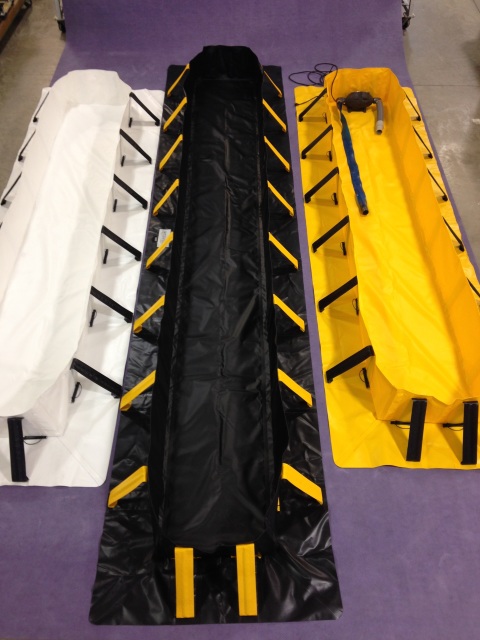
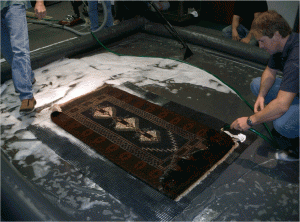
Small wash pit with inflated sides.
Depending on the accessories you buy, I’ve been told by students in the classes that you can spend several thousand and get the basics taken care of.
The tiles used often in the bottom of these types of wash pits, to help elevate the rugs a bit, while also keeping the surface from being too slippery, can be found by Googling “interlocking plastic floor tiles.” Here are some I found in at just two sites I came across in my search, Rubber Flooring Inc. and Cart Wheel Factory.
I have also found pits with inflatable sides prevalent in the automobile mobile washing industry, where water containment is extremely important, and tough material as well with all of the rough surfaces it comes in contact with. This might be another area to research.
I found this car wash mat for $538 on Amazon (they sell EVERYTHING!) => Mobile Car Wash Mat & Containment
You can Google “mobile car wash mat” to find more choices and styles.
The wash pit from the Auserehlian system is much more “serious” with larger side walls, and sturdy inside tiles. The other systems I’ve seen on the market are kind of a toss up between paying for them, or just building it yourself – but not with the Auserehlian option. They build some nice pits. Again, it’s my understanding that this is part of a complete system and that you cannot buy the pit ala carte.
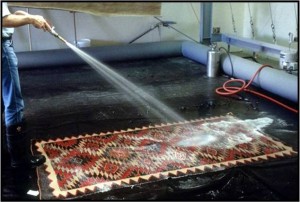
Large size wash pit with system for fresh water exchanges.
BIG bucks => Inclined Wash Floor, Automated Rug Wash Machinery & Tubs
When you graduate from washing rugs in a temporary wash pit and decide to pour a wash floor and acquire some “higher-tech” tools, the biggest cost is not pouring an inclined floor, it will be in running the drainage, and actually having the SPACE to do that in the first place.
There are many ways to construct your floor. Here is one floor where the area doubles as a place to pull in vehicles at night. You can see the trench along the lower half of the slightly inclined floor to capture the water flow.
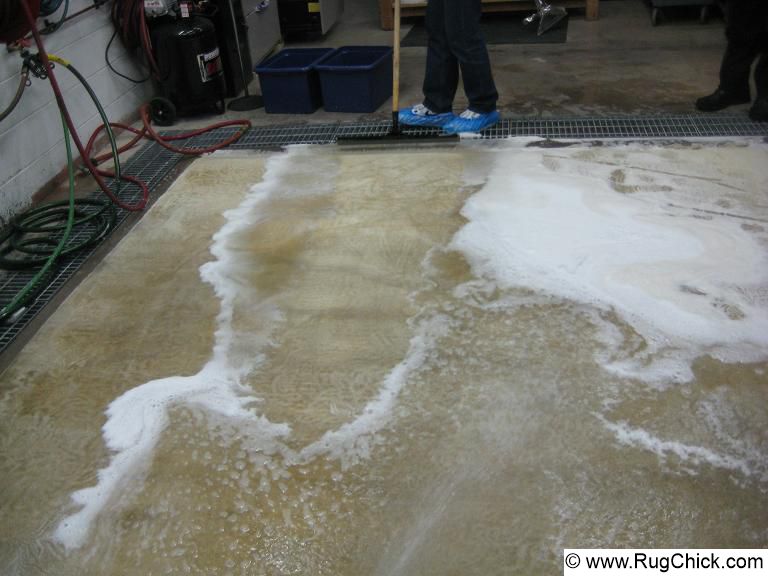
Squeegeeing a rug on the wash floor.
Here are several other wash floor set-ups:
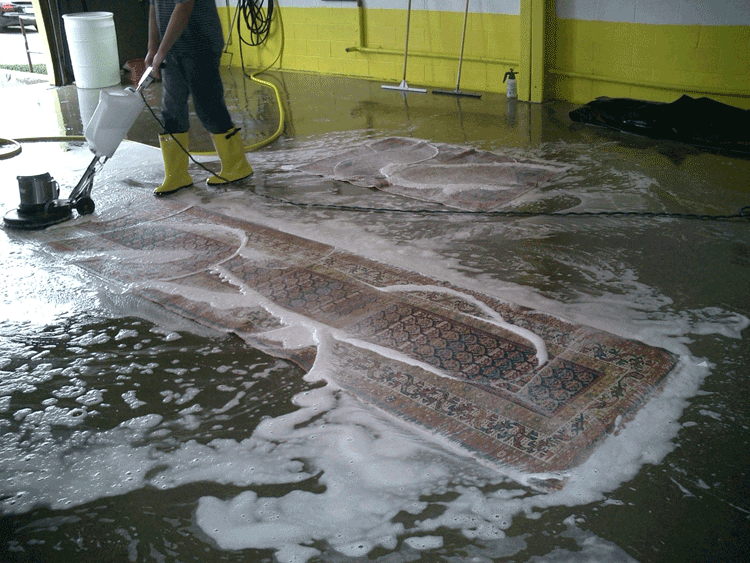
Scrubbing a rug on the wash floor with rotary scrubber.
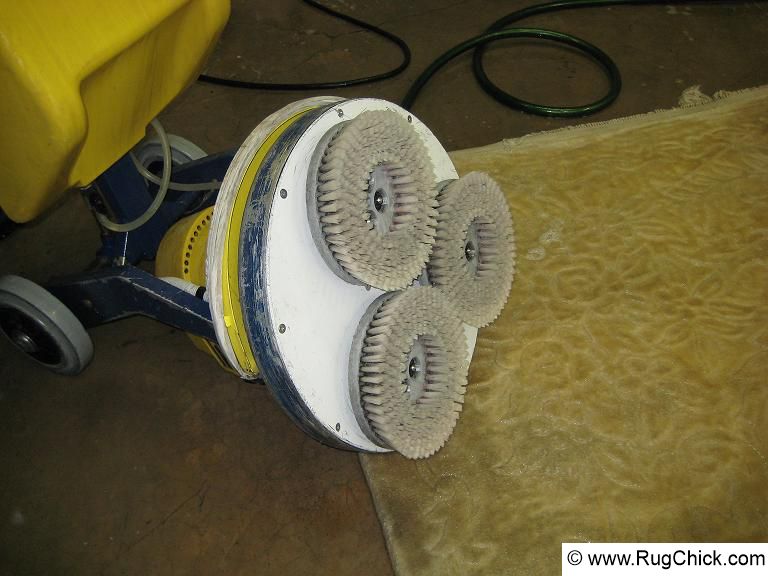
If using a CIMEX machine, use SOFT brushes on rugs.
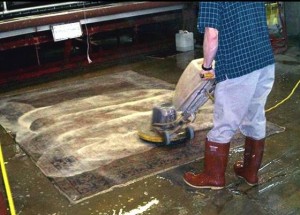
Soft brush head on fully wet rug.
Your brush choice depends on the structure of the rug and how wet you have it (water acts as a buffer to rotary machines). Most large rug facilities have a variety of brushes from rotary scrubbers with soft brush heads, to hand broom brushes (like window washing brushes), to small hand held brushes.
After washing, the rinsing begins, and this can also be done by an assortment of tools, from running clean water underneath a rug and using a squeegee – or a linoleum roller – to help rinse away the suds and soil.
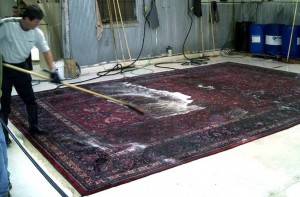
Squeegee being used to rinse away the suds.
Or using a pressure washer to do the same:
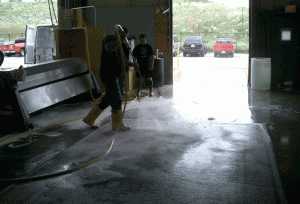
Pressure wash rinsing of rug. Watch the pressure!
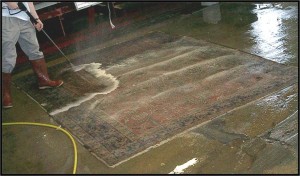
Slow pressure washer rinse of rug before placed in the wringer.
Caption
These methods so far are scrubbing and rinsing on the wash floors, but there also are large rug washing machinery that can do the scrubbing and rinsing in a conveyor belt type “automated car wash” set-up. Though as I mentioned before, the best of the largest rug cleaning companies tend to do “individualized” prep work and cleaning on a wash floor BEFORE they feed the rugs into this type of machine. And some of these facilities turn off the scrub brushes to only use them for the massive rinsing capabilities.
Large automated rug washing machines are sold by several large manufacturers => CarpetWashingMachine.com and TankMakina.com are two of them. You can also find a whole host of manufacturers on Alibaba.com, where you can request bids and get references and additional information on participating companies. Several of my large rug plant peers have used this site to coordinate their overseas purchases.
If you Google “carpet washing machine Turkey” you will find a list of options if you are building a serious rug cleaning facility with serious volume.
There are also rug washing tubs that have come to market. Actually, they have been around for some time, primarily for blanket and quilt washing, but have recently been marketed as for “rugs” as well.
Large automated rug washing machines are sold by Centrum Force, Hanta Systems, and Protima.
I am not personally “sold” on the wash tub concept, especially since they appear to be developed for quilts and blankets, and not specifically “rugs.” But I will see what several of my peers who have purchased units from Greece and Turkey have to tell me once they see my post here. =)
WATER REMOVAL EQUIPMENT
Small bucks => Your EXISTING equipment.
If you already have a cleaning company, you have tools developed for extracting water. Your wand (ideally with Teflon covers to keep from marking any delicate surfaces).
Using a Water Claw (medium size) on the BACK side of the rug can help remove the moisture from the innermost foundation fibers, which tend to be cotton and hold a great deal of water. Many cleaners who start up do this – roll the wet rug on a PVC pipe or plank of wood, and tilt it up against a wall so the weight of the water flows down and away from the rug. After just a few minutes, they lay the rug out to extract the BACK side with a Water Claw, and then follow up with the wand.
The Water Claw portion can take time, so when funds allow (or if you do any restoration work you may already have this), you can add a Dri-Eaz Rover to your equipment. Running about $3,500, this allows you to ride and extract, and the smooth heads leave NO marks on the rug whether you do it on the back side of the front.
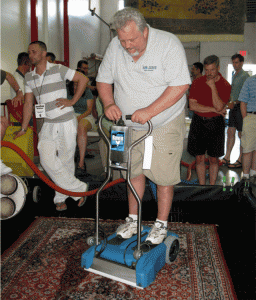
Using a Rover for extracting water.
I have also used an Xtreme Extractor successfully, but have also seen it mark up a rug, so if using that tool, be sure to only use it from the back side. Runs closer to $4,000 – what’s weird is that I saw that price on Amazon. (Again – Amazon sells EVERYTHING! LOL.)
These are good intermediary options, about a tenth of the cost of additional large water extraction machinery. So when you are looking to bump up your production, and are ready to invest $30-50K on a piece of equipment to remove water from rugs, then you are ready for this next batch of options.
BIG bucks => Wringers and Revolution/Centrifugal Machines
Back in “the day” (*ahem*… before my time…) – we had manual wash tub wringers. Cute ones like this:
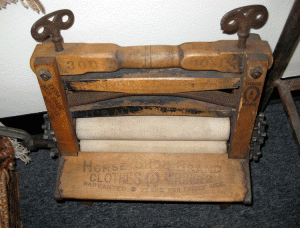
Small hand-crank wash tub wringer for clothes.
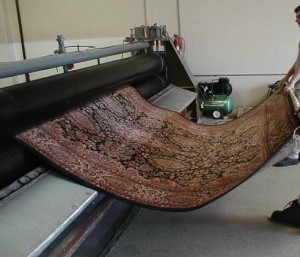
Large rug roller wringer.
Today roller wringers are generally found only second-hand. The trend today is more toward centrifugal wringers which “spin” the excess water out of a rug, similar to your washing machine spin cycle for your clothes. These are called centrifuge wringers.
Two US companies selling these are => Rug Badger Revolution which is a footed stationary model and Centrum-Force centrifuge spin extractors.
The prices all range from $30K – $50+K depending on size and of course leasing added interest. But if you have the volume – and the funds – it is a way to dramatically boost your production. And as mentioned in the very beginning, make sure you have rug training because you will need to know which rugs may structurally be at risk so that you can make adjustments as needed to the controls.
I also found a whole host of centrifugal machines on Alibaba’s website. => Carpet Wringing Machines
Centrifugal spinners are made by Protima, Hanta Systems, Clean Vac, Orbitec Solutions, and Centrum Force.
Hanta Systems in Greece also had several models, as well as videos on all of their product options. (By the way, if the sites do not show English you can click the flag for US or UK to make that happen, or Google has a translator plug-in. Using Alibaba as your portal helps if you get confused on any of these websites – but they are fairly easy to navigate, and to get bids and details from.)
DRYING EQUIPMENT
Small bucks => D-I-Y Hand Pulley Rack System
I’ve seen a lot of make shift rug hanging set-ups. This, like with the wash pit, can be as low-tech or high-tech as you want. You can build something for a few hundred dollars, or go drop $30K or more on a pre-made, electric hoist system for several dozen rugs.
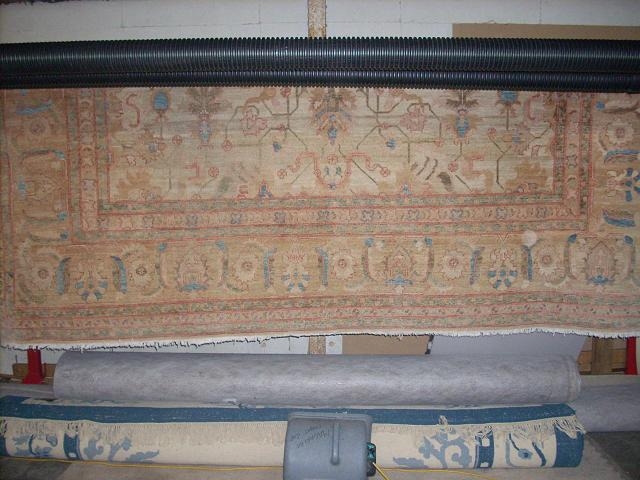
Low tech rack with pipe around it to prevent creasing.
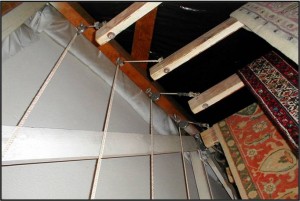
Manual pulley construction with wood planks.
We dry many of our rugs out flat (for various reasons), but have a pulley rack system to hang a few rugs as needed. We use both Dri-Eaz LGR dehumidifiers to control the humidity in our wash facility, and I am a HUGE fan of their Studebaker AirPath air movers.
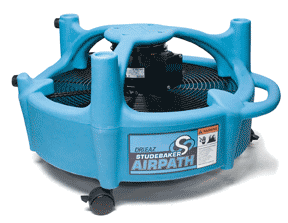
Yes, I’ll admit it… I love the Airpath for speed drying!
We also use their Sahara air movers, just as this D-I-Y guy who created a very creative drying platform for this Kerman rug being washed out of his home. Here is his “speed dry” system for drying his rug out flat (warmer weather helps!):
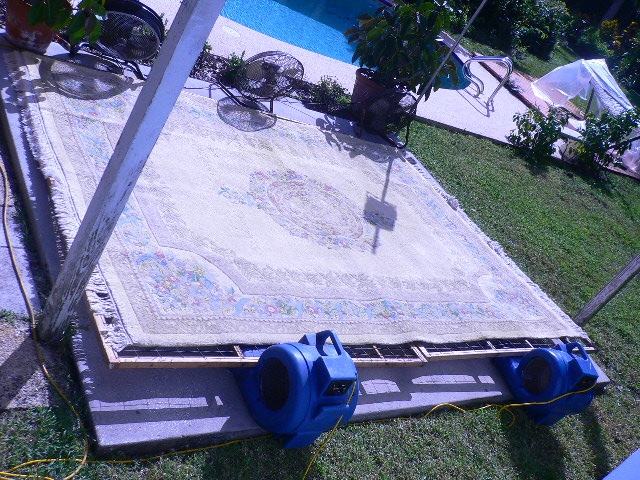
Rug is sun bathing out flat. (Be careful of sun fade.)
BIG bucks => Electric pulley large dry rack systems.
Some large rug cleaning facilities have climate controlled dry towers with 100+ racks in them, and warm air to dry the rugs quickly. If you have the space and the volume, then this may be your choice. Or you may hire a local company to custom build you a system to fit your needs. We paid a local engineer to draft a pulley system that met weight and safety requirements, and had it made out of wood. But again, we dry most of our rugs out flat, so it is not an elaborate rack. This may be more of what you are looking for, a metal mechanized pulley dry rack system:
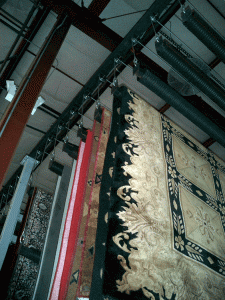
Large dry rack system.
Both small and large drying rack systems are available through Protima, Orbitec Solutions, and Centrum Force. There are also often drying rack systems for sale second hand through rug cleaning forums and social media groups.
The Mother-of-all-Rug-Equipment-Posts is DONE!
I have to say…not only did this take much longer to write than planned…but I did not realize I had so many options to share with you all until I started writing.
I hope this gives you a lot to think about and research in setting up your own rug cleaning operation, and doing it in a smart – and successful – manner.
If you have any questions, or additional ideas for items I missed in this overview, please post in the comments. If you have photos to share with me of “your” set-up, I’d love to see them. Please email them to me at rugchick@gmail.com.
Also – many of the links I referenced as hyperlinks in this post go to specific detailed pages (not simply their home pages), so you can see exactly what pages I was looking at as I was researching specific items.
I hope you found value from this. Now when I’m asked “Lisa, what should I buy…” – I have a BIG post to send them to in order to come up with their own perfect “educated” answer.
– Lisa

